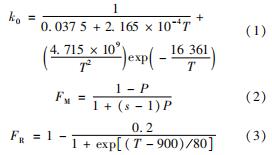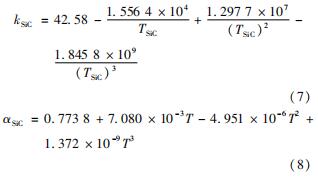多孔弥散微封装燃料以SiC陶瓷为基体材料,TRISO球为燃料,TRISO球随机弥散分布于SiC基体中。因此本研究涉及的材料主要包括SiC陶瓷和UO2陶瓷球。
采用未经辐照、致密UO2的Lucuta修正模型[18]计算其热导率,即

式中:k0为未经辐照的、致密的UO2的热导率,W/(m·K); FM为孔隙度影响因子; P为孔隙度,一般取5%; s为形状因子,球形形状因子为0.5; FR为辐照效应影响因子; T为温度,K。
综合以上因素,UO2燃料核芯的热导率为
kUO</sub>2=k0FMFR(4)
式中kUO</sub>2为考虑各种修正因子后的UO2热导率,W/(m·K)。
UO2的热膨胀系数计算式为

式中:R为玻尔兹曼常数; K1、K2、K3、ED为常数,本文分别取1.0×10-5、3.0×10-3、4.0×10-2、6.9×10-20。
UO2陶瓷球的理论密度为10.96 g/cm3,弹性模量为220 GPa,UO2燃料核芯的泊松比为0.316。
对于TRISO燃料颗粒的内外PyC层,其热导率、热膨胀系数和泊松比分别为4 W/(m·K)、5.5×10-6 K-1和0.23。PyC层的弹性模量[19]为
EPyC=25.5(0.384+0.000 324ρPyC)×(0.481+
0.519BAF)(0.956 027 5+0.000 15T)(6)
式中:ρPyC为密度,kg/m3; BAF为各向异性因子,本文取1.2。
由于SiC层所占体积份额较小,本文在考虑等效均匀化的基础上采用与SiC基体材料相同的材料物性模型,其热导率、热膨胀系数及弹性模量[20]分别为

ESiC=460exp(-3.57P)-0.04Texp(-(962)/T)(9)
式中:kSiC为SiC的热导率,W/(m·K); αSiC为SiC的热膨胀系数,10-6 K-1; ESiC为SiC的弹性模量,GPa。
SiC层的泊松比取常数0.13。
对于疏松热解碳层(Buffer层),其热导率和泊松比分别为0.5 W/(m·K)、0.23。计算中不考虑Buffer层的热膨胀。
疏松热解碳层的各向同性弹性模量[20]为
EBuffer=11.06(0.956 027 5+0.000 15T)(10)
式中Ebuffer为Buffer层的弹性模量,GPa。
根据上述模型,在各复合材料物性的基础上基于体积百分数混合的方法对棱柱型弥散微封装燃料的物性进行初步等效均匀化计算,用于燃料元件性能分析。